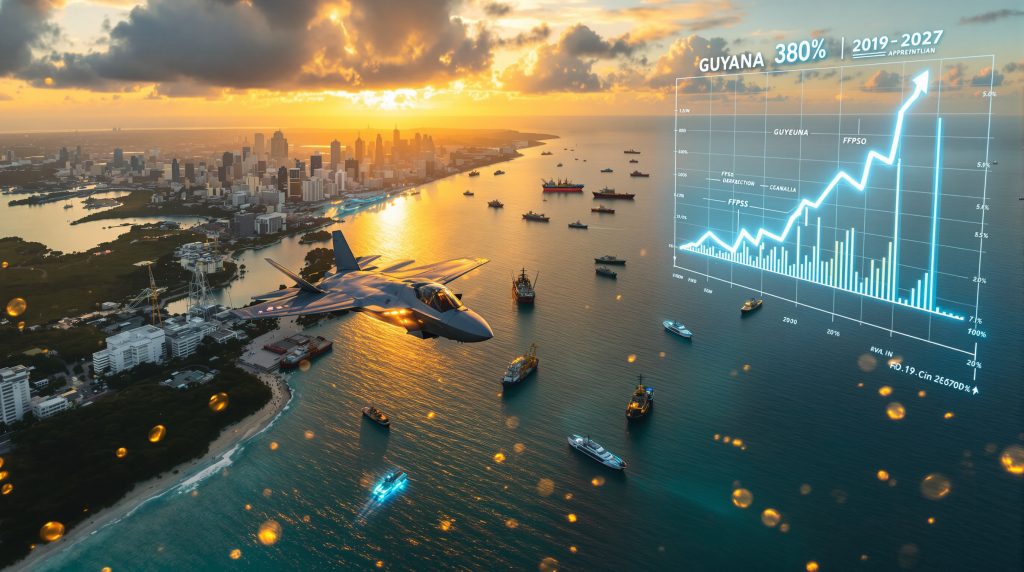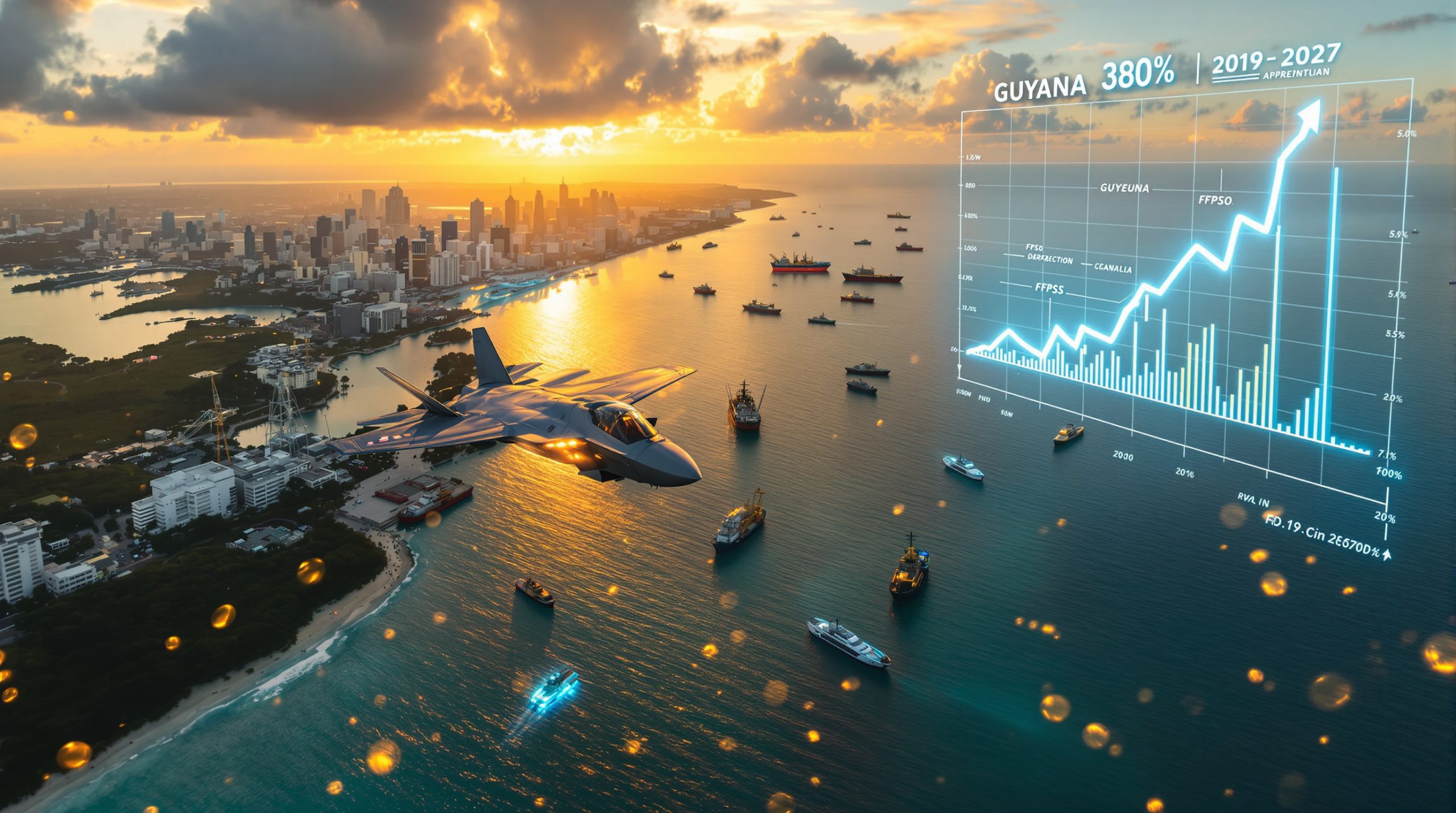U.S. Military Deployment to Guyana: Protecting Oil Interests in a Volatile Region
Guyana has emerged as a critical focal point in global energy geopolitics, with its rapid transformation from a little-known South American nation to one of the world's fastest-growing oil producers. This dramatic shift has attracted significant international attention, including increased U.S. military presence in the region to protect these valuable resources amid rising tensions with neighboring Venezuela.
How is Guyana's Oil Boom Transforming the Caribbean?
Since 2015, Guyana's discovery of massive offshore oil reserves has revolutionized this nation of approximately 800,000 people, catapulting it into the global spotlight and reshaping Caribbean geopolitics. The country's offshore Stabroek Block has yielded approximately 11 billion barrels of recoverable oil equivalent, an extraordinary find for a nation with no previous petroleum industry.
Current production has already reached more than 550,000 barrels per day, with projections suggesting this could exceed 1 million barrels per day by 2027—potentially placing Guyana among the top 20 oil producers globally. This remarkable growth trajectory represents one of the most rapid expansions of production capacity in modern oil industry history.
The International Monetary Fund forecasts Guyana's GDP will continue growing at double-digit rates through 2026, with government revenues projected to increase dramatically as additional offshore projects come online. This economic transformation has fundamentally altered the strategic importance of a region previously overlooked in global energy discussions.
"The scale and speed of Guyana's emergence as an oil producer has few historical parallels," notes energy analyst David Goldwyn, former U.S. State Department special envoy. "For a country this size to go from zero production to potentially a million barrels per day in less than a decade is unprecedented."
Why is the U.S. Deploying Military Assets to Guyana?
Strategic Military Positioning
The United States has significantly increased its military presence in Guyana, deploying advanced fighter jets and conducting joint exercises with Guyanese defense forces. This deployment represents a clear strategic shift in U.S. policy toward the region, driven by several interconnected factors:
- Protection of energy investments: With American companies like ExxonMobil heavily invested in Guyana's oil sector, the U.S. has direct economic interests in maintaining stability
- Regional security concerns: The deployment addresses broader security challenges including narcotics trafficking and maritime security
- Sovereignty support: The military presence signals U.S. backing for Guyana's territorial integrity amid escalating disputes
- Strategic positioning: The move counters increasing influence from other global powers in the Western Hemisphere
Regional security experts note that this deployment creates a comprehensive security umbrella over the region's emerging energy corridor, signaling long-term U.S. commitment to Guyana's development as an energy producer.
Territorial Disputes and Venezuelan Claims
At the heart of regional tensions is Venezuela's longstanding claim to approximately two-thirds of Guyana's territory—the resource-rich Essequibo region. This territorial dispute dates back to the 19th century but has taken on new urgency since the discovery of substantial oil reserves off Guyana's coast.
Venezuela's government has intensified rhetoric around these claims, conducting military exercises near the border and threatening to disrupt oil projects that Venezuela views as encroachments on its sovereignty. Venezuela has also formally objected to international oil companies operating in waters it considers disputed territory.
"The Essequibo dispute represents a complex intersection of historical grievances, resource competition, and geopolitical positioning," explains Dr. Ivelaw Griffith, Caribbean security expert and former university president. "With billions of barrels of oil at stake, what was once a dormant border disagreement has become a potential flashpoint."
The International Court of Justice is currently adjudicating the territorial dispute, though Venezuela has questioned the court's jurisdiction in the matter. Meanwhile, U.S. military presence serves as a deterrent against any potential military action targeting Guyana's oil infrastructure.
How Extensive is Guyana's Oil Production Growth?
Current Production Metrics
Guyana's meteoric rise in the oil sector is unprecedented in recent energy history. From zero commercial oil production before 2019, the country has achieved remarkable growth:
| Year | Daily Production (barrels) | Key Developments |
|---|---|---|
| 2019 | Initial production begins | Liza Phase 1 starts production |
| 2021 | ~120,000 | Second FPSO vessel deployed |
| 2023 | ~340,000 | Liza Phase 2 reaches capacity |
| 2025 | ~550,000 | Payara and Yellowtail online |
| 2027 | ~1,000,000+ (projected) | Multiple additional FPSOs deployed |
This growth trajectory places Guyana among the most rapidly expanding oil producers in history, particularly notable for occurring in a country with no previous oil industry infrastructure or expertise.
The speed of development has been extraordinary, with ExxonMobil and partners Hess and CNOOC making their first discovery (Liza-1) in 2015 and achieving first oil just four years later—an impressively short timeframe for deep-water development.
Economic Transformation
The oil boom has triggered profound economic changes in Guyana:
- GDP growth exceeding 40% in 2022 and continuing at double-digit rates
- Government revenues projected to reach $7-9 billion annually by 2027
- Per capita income rising from approximately $4,800 in 2018 to projected $15,000+ by 2027
- Massive infrastructure development projects including highways, bridges, and power plants
- Creation of a sovereign wealth fund (Natural Resource Fund) to manage oil revenues
These economic benefits come with significant challenges, including concerns about potential "resource curse" effects, environmental impacts, and equitable distribution of wealth across Guyanese society.
"The key challenge for Guyana is ensuring this newfound wealth translates into sustainable development for all citizens," says economist Terrence Blackman of the Guyana Business Journal. "The country must build robust institutions to manage these resources transparently while investing in human capital and infrastructure."
What Are the Regional Security Implications?
U.S. Military Operations and Symbolism
The U.S. military presence in Guyana extends beyond routine exercises, incorporating symbolic gestures that underscore American commitment to the country's security and sovereignty. Joint exercises between U.S. and Guyanese forces have increased in frequency and scope, focusing on maritime security, territorial defense, and protection of critical infrastructure.
These military movements serve multiple strategic objectives:
- Deterring potential aggression toward Guyana's oil infrastructure
- Supporting counter-narcotics operations throughout the Caribbean
- Establishing a forward presence in a region of growing economic importance
- Counterbalancing influence from other global powers interested in the region
The deployment represents a significant shift in U.S. military posture in South America, where direct American military presence has historically been limited compared to other regions.
Escalating Tensions with Venezuela
Venezuela's response to both Guyana's oil development and the U.S. military presence has been confrontational. The Venezuelan government has:
- Conducted naval exercises in waters adjacent to disputed territories
- Issued formal diplomatic protests against oil exploration licenses granted by Guyana
- Threatened action against what it terms "illegal" oil operations
- Characterized the U.S. deployment as "intervention"
These tensions occur against the backdrop of Venezuela's own struggling oil industry, which has seen production decline dramatically over the past decade due to mismanagement, lack of investment, and international sanctions. The contrast between Venezuela's declining production and Guyana's rapid growth adds a competitive dimension to the already complex territorial dispute.
"What we're seeing is a classic case of resource nationalism colliding with the reality of international investment flows," observes Francisco Monaldi, Latin American energy policy expert at Rice University's Baker Institute. "Capital and expertise have flowed to Guyana while leaving Venezuela, creating an asymmetric dynamic that heightens tensions."
How Are International Oil Companies Positioned in Guyana?
Major Players and Investment Landscape
The development of Guyana's oil resources has been led primarily by a consortium of international energy companies:
- ExxonMobil (operator, 45% stake) has committed over $20 billion to developing offshore blocks
- Hess Corporation (30% stake) considers Guyana its most important growth asset
- CNOOC Limited (25% stake) represents Chinese interests in the development
Multiple Floating Production Storage and Offloading (FPSO) vessels have been deployed, with more planned through 2027. Each FPSO represents a multi-billion dollar investment with production capacity of 120,000-250,000 barrels per day.
The economics of Guyana's offshore developments are particularly attractive, with break-even prices estimated between $25-35 per barrel—significantly lower than many other new oil developments globally. This favorable cost structure helps explain the continued investment despite OPEC oil price stagnation.
Production Technology and Environmental Considerations
The development of Guyana's offshore oil fields involves sophisticated deep-water production technologies:
- FPSO vessels serving as the primary production platforms
- Subsea production systems operating in water depths exceeding 1,500 meters
- Advanced drilling techniques to access complex reservoir structures
- Monitoring systems to minimize environmental impacts
Environmental organizations have raised concerns about potential spills and other impacts, particularly given Guyana's limited previous experience regulating offshore oil operations. The country's pristine coastal ecosystems support important fisheries and tourism, creating tension between economic development and environmental protection.
"Guyana faces a steep learning curve in regulating a complex offshore industry," says Melinda Janki, international environmental lawyer based in Georgetown. "The regulatory framework has improved, but environmental monitoring and enforcement capacity remain challenges given the scale and pace of development."
What Does This Mean for Global Energy Markets?
Impact on Global Oil Supply
Guyana's emergence as a major producer comes at a time of significant transition in global energy markets:
- Adding substantial new supply outside traditional OPEC+ control
- Providing light, sweet crude particularly valued for producing transportation fuels
- Offering production with relatively low break-even costs compared to other frontier regions
- Contributing to Western Hemisphere energy security
By 2027, Guyana could account for approximately 1% of global oil production—a remarkable achievement for a country that had no commercial oil production before 2019.
Energy analysts note that Guyana's production growth comes amid uncertainties about long-term oil demand growth, as energy transition efforts gain momentum. However, the low production costs and high-quality crude from Guyana's fields make them competitive even in scenarios with moderating oil demand.
Geopolitical Realignment
The oil boom has triggered a significant realignment of Guyana's international relationships:
- Strengthened ties with the United States, including security cooperation
- Increased engagement with other major powers seeking energy partnerships
- Enhanced regional influence within Caribbean and South American forums
- Growing diplomatic capacity to manage complex international relationships
This realignment represents a fundamental shift for a country that previously had limited geopolitical significance, demonstrating how energy resources can rapidly transform a nation's international standing.
"Guyana is experiencing what can only be described as compressed development—not just economically but diplomatically," says Caribbean affairs specialist Riyad Insanally, former Guyanese ambassador to the United States. "The country must now navigate complex relationships with global powers while building institutional capacity at an unprecedented pace."
How Might the Situation Evolve?
Potential Conflict Scenarios
While full-scale military conflict remains unlikely, several scenarios could lead to escalation:
- Confrontations between naval or coast guard vessels in contested waters
- Disputes over oil exploration or production activities near borderlines
- Diplomatic crises triggered by resource development activities
- Proxy conflicts through non-state actors in border regions
The presence of U.S. military assets significantly alters the risk calculation for potential aggressors, likely deterring direct military action against Guyana's oil infrastructure but potentially increasing rhetorical tensions.
Security analysts suggest that incidents at sea—such as confrontations between Venezuelan naval vessels and oil exploration ships—represent the most probable flashpoint, given the maritime nature of Guyana's oil development and the ambiguity surrounding territorial waters in the disputed region.
Diplomatic Pathways
Several diplomatic avenues exist for managing the territorial dispute:
- International Court of Justice proceedings (currently ongoing)
- Regional mediation through organizations like CARICOM or the OAS
- Bilateral negotiations on resource sharing or joint development
- International guarantees of territorial boundaries and resource rights
The effectiveness of these pathways depends largely on the willingness of all parties to engage in good-faith negotiations, which remains uncertain given the high economic stakes and domestic political considerations.
"The international legal process offers the clearest path to resolution, but requires all parties to accept the court's jurisdiction and eventual ruling," explains international law expert Christine Bell. "History suggests resource disputes are most effectively resolved through negotiated settlements that offer economic benefits to all parties."
What Are the Investment Implications?
Energy Sector Opportunities
The development of Guyana's oil resources presents significant investment opportunities:
- Continued expansion of production infrastructure
- Development of support services including logistics, maintenance, and supplies
- Potential downstream projects including refining and petrochemicals
- Associated natural gas monetization through power generation or export
These opportunities extend beyond the major international oil companies already present, creating openings for service providers, infrastructure developers, and local businesses. However, investors must consider both the potential rewards and the geopolitical risks inherent in a frontier region with territorial disputes.
The ongoing US‑China trade war creates additional complexity for international investors, as tensions between major powers can influence energy market dynamics. Moreover, the potential trade war oil impact could significantly affect pricing and demand patterns for Guyana's exports.
Investment analysts highlight that companies with existing positions in Guyana's offshore blocks have significant advantages, given the technical knowledge they've developed about the basin and their established relationships with the government. New entrants face greater challenges but may find opportunities in supporting industries or in blocks not yet licensed.
Defense and Security Sector Growth
The increased security focus on the region creates additional investment potential:
- Maritime security systems and coastal monitoring
- Training and capacity building for Guyanese security forces
- Infrastructure hardening and protection services
- Cybersecurity for critical energy infrastructure
The U.S. military presence likely accelerates development in these sectors, potentially creating opportunities for defense contractors and security service providers with experience supporting offshore energy operations in complex environments.
"Energy security and physical security are increasingly intertwined in regions like Guyana," notes security consultant Thomas Cullen. "Companies that can bridge these domains—offering integrated solutions that protect both physical assets and operational technology—will find growing demand for their services."
Balancing Development and Sovereignty in a New Energy Frontier
The deployment of U.S. jets to Guyana as oil boom raises Caribbean stakes represents a significant evolution in Caribbean geopolitics, directly linked to the country's extraordinary emergence as a major oil producer. This military presence serves multiple objectives—protecting valuable energy resources, supporting a strategic partner, and maintaining regional stability in the face of territorial disputes.
As Guyana continues its remarkable production growth toward 1 million barrels per day and beyond, the strategic importance of the region will only increase. The interplay between energy development, territorial claims, and great power competition creates a complex security environment that will shape the Caribbean's geopolitical landscape for decades to come.
For Guyana itself, the challenge remains balancing rapid development with sustainable growth—leveraging newfound wealth to improve infrastructure, education, and social services while avoiding the "resource curse" that has afflicted many oil-rich developing nations. The country's success will depend not just on barrels produced but on how effectively the benefits are distributed among its citizens.
The U.S. military deployment signals that Washington views Guyana's energy resources as strategically significant enough to warrant direct security guarantees—a clear indication of how dramatically the discovery of oil has transformed this previously overlooked corner of South America into a focal point of global energy geopolitics.
Managing Environmental and Social Impacts
Beyond the geopolitical dimensions, Guyana faces significant challenges in managing the environmental and social impacts of its oil boom. Environmental organizations highlight concerns about marine ecosystem protection, potential oil spills, and the carbon footprint of extensive offshore development.
The government has established environmental regulations and monitoring systems, though critics argue these remain insufficient given the scale and pace of development. International standards and practices brought by major oil companies provide some safeguards, but the ultimate responsibility for environmental protection rests with Guyanese institutions still building capacity.
Social impacts present equally complex challenges. Rural communities and indigenous populations worry about being left behind in the economic transformation, while urban areas face infrastructure strains and rising costs of living. Managing these tensions requires thoughtful policies that ensure benefits flow beyond Georgetown to all regions of the country.
With increased commodities market volatility affecting global markets, many investors are seeking opportunities in emerging energy markets like Guyana. Some analysts are even recommending examining an ETC investment guide to gain exposure to Guyana's growing energy sector without direct investment in operational assets.
"The greatest risk for Guyana isn't external but internal—ensuring that oil wealth strengthens rather than weakens democratic institutions," cautions political economist Matthew Bishop. "Countries that establish inclusive institutions and transparent governance early in their resource development tend to fare much better than those that don't."
For international observers and investors alike, Guyana represents a fascinating case study in real-time—a nation undergoing compressed development that would typically unfold over generations. The presence of U.S. military assets adds another dimension to this already complex picture, highlighting the strategic importance of energy resources in an era of great power competition.
Ready to Spot the Next Major Mineral Discovery?
Discover how the proprietary Discovery IQ model from Discovery Alert identifies significant ASX mineral discoveries instantly, helping investors gain a market-leading edge before the broader market responds. Explore why historic discoveries can generate substantial returns by visiting Discovery Alert's dedicated discoveries page and position yourself ahead of the market with a 30-day free trial.




